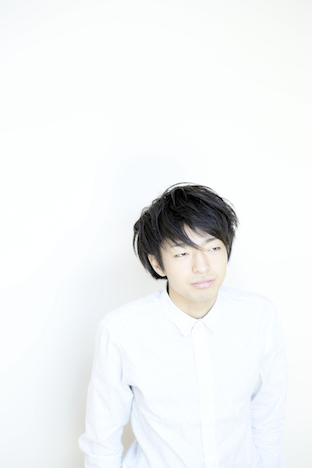澁木智宏Tomohiro Shibuki

© Tomohiro Shibuki
Tomohiro Shibuki, a Tokyo-based textile designer and an artist, mainly creates artworks by needle wool felting. His works show the importance of thinking how his works should be exhibited in relationship with others. He creates artworks carefully by hands. They use the motif of simple natural things like stones or cloud. They guide his audience’s heart to the scene of unknown story.テキスタイルのデザインワークと、ウールを中心としたアートワークを往復しながら、東京を拠点に国内外で活動する澁木智宏。彼の作品は、他者との関わりの中で『作品をどのように見せるか』という視点を重視しながら、どこにでもあるような石や雲などのモチーフを細密な手仕事で表現しては、誰も知らない物語の一場面へ人の心を誘う。
![]()
まずはじめに、自己紹介をお願いします。
![]()
ウールを用いた作品制作を主に行うアーティスト、またフリーランスのテキスタイルデザイナーとして活動しています。
![]()
テキスタイルデザインと平行してアートワークを行っているのはなぜですか?
![]()
テキスタイルデザインの活動は衣服やインテリアとジャンルは様々ですが、素材との対話やパターンデザインはアート活動と同様に自身を表現できる場で あると思っています。デザインワークは多くの人と一緒になって動かす外へ向けての活動、それとは逆に、アートワークは自分自身を見つめる内に向けての活動 が中心です。デザイン脳とアート脳を行ったり来たりすることは、どちらの表現にも良い影響を与え合っていて、良いバランスをとることができているなと思います。
![]()
澁木さんの作品を写真で見ると、その見せ方にも澁木さんらしさを感じます。
![]()
作品を作る際、視覚的に感動があるか、驚きはあるかというのは大きな指針になっています。作品を作り、それをどのように見せるかというのも実作品と同じくらい大事なことと思っています。
![]()
ライフワークとしてウール100%の「ici」(イシ)シリーズを制作されていますね。一見すると本物の石のようにリアルですが、持ってみると軽く、固そうに見えて柔らかく、冷たそうに思えて暖かく、視覚と触覚のギャップが面白いです。
![]()
ウールを用いた作品制作の最初の作品であり、今も作り続けている作品です。私が選ぶモチーフ、素材はとても身近なものが多いです。石はその代表例かもしれません。自然物は物言わずして、多くを語りかけてきます。それは時として色々なことを伝えてくれます。石もその一つで、だからこそ石が好きな人が多くいるのではないでしょうか。
![]()
この作品を作るきっかけは、石が好きというのはもちろんですが、身近なものに目を向けること、ちょっとした視点の変化で面白くなるというのを感じてもらえたらと思いで作り始めました。どんなにリアルに作っても、本物の石にはなれません。作れば作るだけ、刺せば刺すだけ、本当の石がより一層際立ち、また多くを語ってくれる気がします。だからこそ作り続けているのだ思います。
![]()
澁木さんは北海道小樽市のご出身ですね。北海道でお気に入りの場所を教えてください。
![]()
一つは北海道共和町にある「神仙沼」です。有名な観光スポットですが、帰省するたびに必ずと言っていいくらい向かう場所です。入り口から林の中の遊歩道を歩いてある程度まで行くと湿原が広がってきます。そして、最終地点が神仙沼という行程です。 林道では木々の自然が目の前で観察でき、湿原地帯では視界が開け遠くの山々とのダイナミックな景色が広がり、神仙沼ではひっそりと佇む静な空間になります。総時間数十分ですが、様々な自然の表情を見ることができます。
![]()
二つ目は札幌市の「モエレの沼公園」です。「神仙沼」は自然の形を残して、ミクロとマクロの自然を短い行程で感じることができるのに対し、「モエレの沼公園」は人の手によって、それを感じさせるという点で反対の立ち位置にあると思います。どちらにも魅力があり、近い距離で両方を体験できるというのは北海道ならではだと思います。
![]()
Text: Ayumi YakuraPlease introduce yourself first.
![]()
I am an artist who creates some wool-artworks and a freelance textile designer.
![]()
Why do you wear two hats; as an artist and textile designer?
![]()
I often think that pattern designing and listening to materials are same representation to express myself, while the fields of textile design are diverse like fashion and interior. Firstly, designing is the work towards outside; act with many people. Secondly, art-creation is the work towards inside; see and talk to myself. Those two activities, designing and creating art works, always enhance each other in my brain. For me, it is really helpful that swaying to and fro between these two different kinds of activity keep good balance of creation in my works.
![]()
I can find your unique way of presentation through pictures in which your works caught.
![]()
Impressing audience visually is one of my great guiding principles of creation. Thinking about the process of exhibition is very important as much as the actual artworks itself.
![]()
You have created “ici” (means stone) series by all-wool as your lifework. It looks like a real stone, heavy, hard, and cold. However actually it is light, soft and warm. The gap between vision and tactile is very unique.
![]()
This is my first wool-artwork and I have been working till now. Most of motifs I choose for my work are something familiar in our daily life. Stone is a good example of those. Nature things such as stones express many things without words. I think that’s why many people love it. The reason to start this project was, firstly, I love the stone of course.
![]()
Another reason is that I hope my audiences feel it is interesting to pay attention to familiar things in their daily life, that is, everything can be more interesting by a little change of the point of view. My artworks cannot be real stone after all. However, the more I create, the more the existence of real stones would be emphasized. I feel my artworks tell me more things as I create. That’s how I can keep motivation to do my work.
![]()
You are from Otaru city, Hokkaido. Please let us know your favorite places in there.
![]()
There are two favorite places. One is “Shinsen-numa (Shinsen-mursh)” n Kyowa-cho. It is one of the famous sightseeing spots, and I go there almost every time when I return to my home. The way to “Shinsen-numa” starts from the promenade in the woods. Walking for a while you will find the marshlands, and finally “Shinsen-numa” will show up at last.
Along the forestry road, you can see the nature closely. Then, the dramatic scenery of the mountains will spread in front of your eyes. Furthermore, you will also feel the silent atmosphere of “Shinsen-numa”. It’s only several tens of minutes walking. However, you can see the various sceneries of the nature.
![]()
Another one is “Moerenuma-Park” in Sapporo. “Shinsen-numa” is in a natural state. You can feel the micro and macro of nature when you go for a short walk. “Moerenuma-Park” is different from Shinsen-numa in that the latter is in natural state too, but also all made by hand. However, I think you will be able to have the same feeling of what you feel at “Shinsen-numa”. Both of these places are very beautiful and majestic. I think Hokkaido is one of the best places to visit these two places nearby.
![]()
Text: Ayumi Yakura
Translation: Haru Murayama, Shigeru Nakamura
